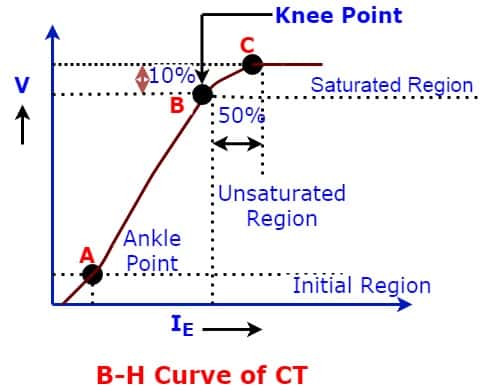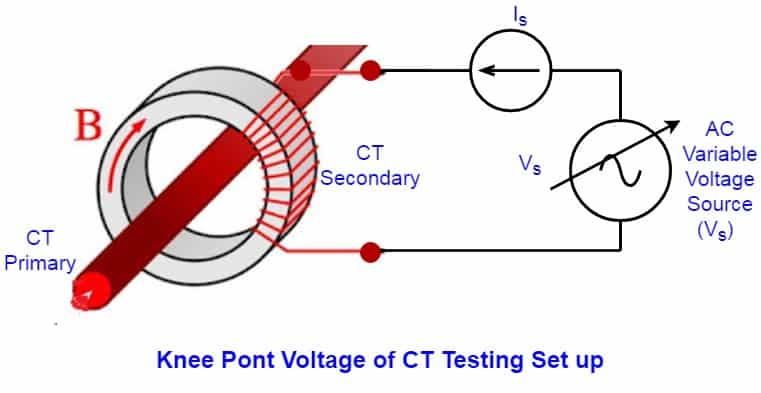In this article we will discuss the use of knee point voltage of current transformer in the protection circuit. The knee point voltage of CT is very important parameter that needs to be checked before use of CT for an electric circuit.
What is Knee Point Voltage(KPV)?
As per IEC, the knee point voltage is defined as the voltage at which a 10% increase in applied voltage increases the magnetizing current by 50%. For voltages greater than the knee point voltage, the magnetizing current increases considerably even for small increments in voltage across the secondary terminals.IEEE defines saturation as “the point where the tangent is at 45 degrees to the secondary exciting amperes”. Also known as “knee” point.
The KPV shows the saturation limit of the current transformer. When CT goes into its saturation region, the core of the CT is no longer able to confine the magnetic flux in the core. Under saturation, the CT behaves as an open circuit, and its output is zero. Therefore, the protection class CT must operate in its non-saturation region. To ensure the operation of the CT in the non-saturation region, we need to calculate the maximum allowable secondary winding voltage limit up to which CT remains in its non-saturation region.
Graphical presentation of KPV of CT

Knee Point Voltage Testing Procedure
The secondary of the current transformer is connected to an alternating voltage source(AC), and the CT’s primary is left open. The KPV testing setup is given below.

As the secondary voltage increases, keeping the primary of CT open, the current in the secondary increases with the increase in voltage. At a particular voltage, the secondary current increases drastically, and that point corresponds to the KPV of CT.
The secondary voltage is increased by 10 % in steps, and the corresponding current is measured. The current and voltage is noted. The point where the 10 % increase in the voltage causes a 50 % increase in the current is the knee point voltage of CT.
The CT testing current and voltage are tabulated below.
| Secondary Voltage (Volt) | Secondary Current (Ampere) |
| 3 | 0.001 |
| 7.5 | 0.002 |
| 12.5 | 0.003 |
| 18 | 0.004 |
| 60 | 0.01 |
| 150 | 0.02 |
| 200 | 0.025 |
| 235 | 0.03 |
| 300 | 0.05 |
| 356 | 0.08 |
| 372 | 0.01 |
| 400 | 0.15 ( CT Saturation Point) |
| 447 | 1.0 |
Significance of Knee Point Voltage
The knee point voltage parameter is very important for protection class current transformers, especially for Class-PS, which is a special-purpose current transformer used for zone protection. The current transformer used for protection and differential protection has to carry 20 to 30 times the CT-rated current during fault conditions.
If the CT saturates under fault conditions, the protection relay does not trip the breaker, and it may cause heavy damage to an electrical network. Knee point Voltage is very important in view of instrument safety factor as well. The KPV of CT must be known for the protection class CT and PS (PS class- Protection Special) class CT.
Read Next:
Nice 👍 contents.